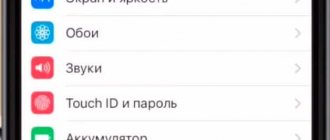The issue of downloading and then saving documents and other files is not a big deal if you are working on a computer or an Android smartphone. But when using an iPhone or iPad, the situation is different. Apple isn't particularly proactive about allowing iOS users to directly download files. But there are still working methods. In this article, we will tell you how you can download the required files to your iPhone and iPad.
♥ ON TOPIC: Which iPhone has better battery life? Comparison of battery life of all current iPhones in 2020.
Where are files saved on iPhone and iPad?
One of the most frustrating problems with iOS devices was the lack of a traditional file system to work with local files. On the one hand, this is great, because thanks to this it is protected both from outside attackers and from the crooked hands of users who can accidentally break something.
However, with the advent of the Files app on iPhone and iPad, this problem has been solved to some extent. However, it is too early to talk about a full-fledged solution; there are significant differences between Android and Windows. But this approach is already able to satisfy most user needs, and with the release of iOS 13, even more opportunities for working with files have appeared.
Previously, it was not possible to download files to iPhone and iPad because there was no way to manage them. Now, if you download a file, document, or even a video on your iPad or iPad, they will all be saved directly in the Files app right on the device. The iCloud Drive directory in the Files app has a Downloads folder where iOS saves all downloaded files by default.
This automatically creates a backup copy of all downloaded files and then syncs it across all your Apple devices under one Apple ID (iCloud) account.
♥ ON TOPIC: How to transfer a Wi-Fi password to someone else’s iPhone or iPad “in one tap” without revealing it.
Use tags for sorting
In addition to folders, you can also use tags. To do this, hold down the file and select Tags.
The Files app arrived in iOS 11 and is a great addition to a system that has ignored document organization methods for many years.
Due to such a sad history of iOS, many users do not quite understand why they need a file organizer at all and how to work with it. We tell you how to get the most out of one of the most invisible, but very important innovations in iOS 11.
Don't limit yourself to Apple services
By default, the file manager on iPhone and iPad only works with iCloud Drive cloud storage. But it also supports third-party analogues. For example Dropbox. To activate them, you need to press the “Change” button at the top of the interface, and then enable all the necessary services.
Files can be sorted into folders
Just like on a Mac computer, in the file manager on iOS you can create new folders and put whatever you want there, including documents, photos and audio recordings. At the same time, you can create folders not only on the device itself, but also in any connected cloud storage. The button to create a folder is located below the search bar.
You can also sort documents by tags
You can share multiple files from different cloud storages at once
Tags will help here too. Using them, you can combine several files located in different services into one group. And then send it to anyone with one click.
Files from the Internet can be saved directly to iPhone
Deleted files can be returned
The iOS file manager has a trash can. All deleted files go there and are stored, in case the user changes his mind about getting rid of any of the documents or photos. To restore, you just need to open the “Recently Deleted” folder, select the desired file and click the “Recover” button.
You can manage files from your computer
Files on iOS and Finder on macOS are closely related. Closer than many people think. In the iCloud Drive cloud, a separate space is allocated for the computer desktop and for documents stored on it. They are constantly synchronized, which means that from your iPhone you can save the file to your Mac desktop. Moreover, they even have one basket for everyone. Files deleted from a Mac can be viewed and restored on a smartphone or tablet.
You can choose which programs the files will be opened in.
Perhaps these 8 simple tips will help you quickly master the Files application and learn something new about it.
View and manage your files from any iPhone, iPad, or iPod touch. The Files app makes it easy to find the files you need, no matter where they're saved or what device you're using.
The Files app brings all your files together. It is very convenient here to view, search and organize your files located not only on the device you are currently using, but also in programs, iCloud Drive storage and other cloud services.
How to change the location of the Downloads folder on iPhone and iPad?
In addition to Safari, there are many other web browsers for iPhone and iPad in the App Store. However, you can only download files and media to your device using the Safari browser. The default download location in Safari is iCloud Drive storage in the Files app, which will fill up very quickly if you're on the free 5GB plan. Therefore, you should definitely consider changing the download location to your device's local storage instead of iCloud cloud storage. For this:
1. Open the Settings app on your iPhone or iPad.
2. Scroll down and find the Safari section.
3. Find the “Downloads” option and click on it.
4. Select "On iPhone" or "On iPad", changing the previous iCloud Drive option.
5. You can also click “Other...” to select another directory of your choice.
Now all the files you download to your iPhone or iPad will be saved in their local storage. You can find them using the Files app on your device.
♥ BY TOPIC: How to turn off the sound (clicks) of the keyboard on iPhone or iPad.
Search files
To access files, open the Files app and select the location of the file you want.
Save a local copy of a file
Files stored locally are found in the On [device] folder on the Places screen. To save files directly to your iPad, simply drag them into the On iPad folder. To save a file locally on your iPhone or iPod touch, follow these steps.
- Browse to the file you want to save to your device.
- Click Select > file name > Place.
- In the On [device] folder, select a folder, or click New Folder to create a new one.
- Click "Copy".
You can also long press on the file, then select the Move command and the folder where you want to copy the file.
In iOS 12 or earlier, tap the file you want and select Move. Then, in the On [device] folder, select Numbers, Keynote, or Pages and click Copy.
Move files from iCloud Drive
- Browse to the file you want to move.
- Click Select, then select a file.
- Click Post.
- In the On [device] folder, select a folder, or click New Folder to create a new one.
- Click Move.
You can also long press on the file, then select the Move command and the folder where you want to copy the file.
View files on other devices
Follow the steps for the appropriate device.
- On your Mac, choose Finder > iCloud Drive.
- On iCloud.com, go to the iCloud Drive app.
- On a PC running iCloud for Windows, go to File Explorer > iCloud Drive.
How to download videos to iPhone and iPad from the Internet?
Downloading videos, especially from YouTube, Facebook, VKontakte, Instagram and other platforms, is very important for iOS users. Most of us usually try to somehow record a video for later viewing from our device without access to the Internet. Here are the methods to download videos on iPhone and iPad.
1. Open the page from where you want to download the video and copy the link to the video. The screenshots below show an example of downloading a video to an iPhone from YouTube.
2. Open, for example, the site 9xbuddy.org or choose another one from our review of sites that are used to download videos from social networks and paste the copied URL into the specified field.
3. Click the "Download" button and select the quality of the downloaded video.
4. In the pop-up window that appears, click “Download”. A Download icon will appear in the top right corner of Safari, showing your download progress.
5. The downloaded video will be saved in the Downloads folder of the Files application.
6. If you want to save the downloaded video to the Photos application, then launch the video in the Files application and click the Share → Save Video button.
The video will be saved in the Photos app's Video folder.
♥ ON TOPIC: Which smartphone has the best camera in 2020 - Top 10.
How to download documents (files) to iPhone and iPad?
As with any other file type, the process of downloading documents to iPhone and iPad has become much easier. You can download files in a variety of formats, be it PDF documents, Word, Excel, PowerPoint, .zip, .txt, .mp3, .M4a, .wav, .mov and so on. The downloaded file will appear in the Downloads directory of the Files application.
1. Go to the desired web resource (site) in the Safari browser.
2. Press and hold the link with the document file that you need to download to work on your iPhone or iPad.
3. In the pop-up menu that appears, select Upload file via link.
4. Click the download icon on the Safari tab to view and open the downloaded document in the Files app.
Luckily, iOS now supports almost all major document formats, including Doc, Docx, PPTX, PDF, and more. If you want to download and save documents received via WhatsApp, Telegram, Viber, then follow these steps. The screenshots below show an example of downloading a document to an iPhone from the WhatsApp application.
1. Upload the document file that you received in the messenger.
2. Open the file from the chat window.
3. Click the Share icon in the top right corner.
4. Select Save to Files.
5. Select the desired directory and click "Save".
Likewise, you can save documents from various apps to your iPhone's file system without much hassle.
♥ BY TOPIC: How to scan documents on a Mac using an iPhone instead of a scanner.
How to download songs to iPhone or iPad?
If you've ever used Android, then remember the ability to download or transfer music as a file and then play it using any music player of your choice. Apple does not approve of directly transferring MP3 files to an iPhone or iPad and then playing them using any media players. The easiest way to download songs on iPhone is to use streaming services such as Apple Music, Yandex.Music, Google Music, Spotify, etc. But they are all paid.
If you still want to download MP3 files to your iPhone and share them with your friends, then that is possible too. You can download MP3 files from various web sources and save them in the Files app. You may not be able to see them in Apple Music or other apps. However, you can play music from files. Here's how you can download songs to iPhone.
1. Launch Safari browser on iPhone.
2. Go to the web resource from which you want to download songs.
3. Click the "Download" button.
4. Select "Download" from the pop-up question.
5. Click the "Downloads" icon in the upper right corner of the window to see the download progress.
6. When the download is finished, you can click on the file name in Safari's download list to play the music.
Alternatively, you can go to Files → On iPhone/iCloud Drive → Downloads to find your downloaded music and share it with your friends via WhatsApp, AirDrop or other apps.
♥ ON TOPIC: How to set a password of 4 characters (numbers) instead of 6 on your iPhone or iPad.
How to download zip archives on iPhone?
Downloading zip files on iOS and iPadOS is no different from the above media file types.
1. Open Safari, an email program or instant messenger that contains a ZIP archive of files.
2. After touching the archive file, it will be automatically downloaded to the Downloads folder (if the file was downloaded from Safari) or a preview will open in which you need to click the Share button and then select Save to Files.
Select the required folder and click "Save".
3. Open the Files application.
4. Go to your Downloads folder.
5. Click on the Zip file to extract it in the same directory.
♥ ON TOPIC: All functions of the buttons of the original headphones included with the iPhone.
Quick commands
If you don't like the limitations of iOS, the new Teams app will make things a little better. This is the default automation app in iOS 12. It can do things that no other app on the App Store can do. You can perform complex chains of actions with one touch.
You can also use ready-made shortcuts from other users. For example, the Video Downloader command allows you to download videos from almost all sites, including Facebook, YouTube, DailyMotion, Vimeo, Twitter, etc.
There is a YouTube Ripper command that allows you to extract and download audio from videos. To use both commands, you need to open the video, click the Share button, select the Commands app, and launch the command. Once the video or audio is downloaded, you can choose where to save it - iCloud Drive or Dropbox. You will also be able to open the file in other applications like VLC or Documents.
- Download : Video Downloader Shortcut
- Download : YouTube Ripper Shortcut










